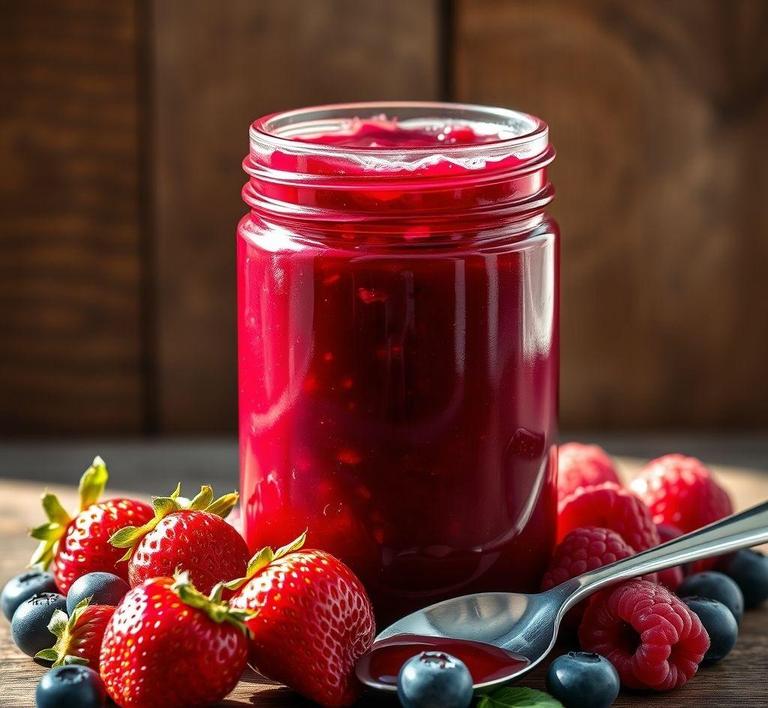Making freezer jam is a fun and easy way to preserve the fresh taste of fruits, but what happens if you don’t use it all at once? You might be wondering if it’s safe to refreeze freezer jam. The good news is, it’s definitely possible to refreeze it, but there are a few things to keep in mind to make sure it stays as delicious as when you first made it. In this guide, we’ll walk you through the best practices for refreezing freezer jam, from storage tips to how to maintain that fresh, fruity flavor even after it’s been frozen and thawed.
Can You Refreeze Freezer Jam?

Freezer jam, a beloved preserve for its fresh, fruity taste and simplicity of preparation, has long been a favorite of home canners. But once you’ve thawed a jar of freezer jam, a common question arises: Can you refreeze freezer jam? The answer isn’t a straightforward yes or no, as it depends on several factors, including the state of the jam, how it was stored, and how long it has been thawed.
The primary consideration when thinking about refreezing freezer jam is food safety. Freezer jam is typically made with a high sugar content, pectin, and fresh fruit, which gives it a short shelf life compared to traditional canned jam. Once thawed, the texture, flavor, and quality of the jam start to change. Refreezing the jam might not only alter its taste and texture but could also introduce the risk of spoilage if not handled correctly.
From a food safety perspective, it’s generally not advisable to refreeze any product once it has been thawed, especially if it was not kept at a consistently cold temperature. When freezer jam is thawed and then refrozen, the natural fruit sugars and pectin break down further, leading to a loss of structure. There’s also the possibility that bacteria could develop, which might cause the jam to spoil. Refreezing it after it has been at room temperature for an extended period or after it has thawed improperly could increase the chances of foodborne illness.
How To Refreeze Freezer Jam?
While the act of refreezing freezer jam is not recommended, there are situations where it might be acceptable-under the right conditions and if you’re aware of the potential changes in quality. Here’s how you can go about it:
- Inspect the Jam: Before even considering refreezing, check if the jam was thawed properly and hasn’t been left at room temperature for too long (ideally, not more than two hours). If it was thawed in the refrigerator, and you’re confident it’s still within its safe consumption window (usually 3-4 days after thawing), refreezing is less risky.
- Refreeze Promptly: If you decide to refreeze your jam, do so as quickly as possible. Place it back into the freezer as soon as you notice it’s starting to thaw. The longer the jam sits at room temperature, the higher the risk of bacterial growth.
- Use Airtight Containers: When refreezing, make sure the jam is stored in airtight containers. This will help preserve the flavor and prevent freezer burn. Ensure the containers are sealed well to avoid any air exposure, which can dry out the jam and alter its texture.
- Avoid Thawing and Refreezing Multiple Times: It’s best not to go through the thaw-and-refreeze process multiple times. Each time freezer jam is thawed and refrozen, its texture degrades further, and the flavor can diminish. Ideally, refreeze only once to minimize these changes.
- Label and Date: When refreezing the jam, be sure to label the jar or container with the date it was initially made and the date it was refrozen. This helps keep track of how long it’s been in the freezer and ensures it’s used within a reasonable timeframe.
Quality Impact
While it’s possible to refreeze freezer jam under certain conditions, the quality is likely to suffer. Here’s a closer look at how refreezing might affect the jam:
- Texture: Freezer jam typically has a fresh, smooth, and slightly chunky texture that is preserved when frozen. However, after refreezing, the consistency tends to become more watery and runny. The fruit pieces may break down more, leading to a mushier, less appealing texture.
- Flavor: Freezer jam has a vibrant, fruity flavor that is one of its main selling points. But when refrozen, the jam can lose some of its brightness and sweetness. Refreezing may cause the sugar to crystallize or cause the fruit’s natural flavors to become muted or soggy. If the jam isn’t refrozen soon enough, it could also start to develop off-flavors from oxidation or spoilage.
- Separation: Another sign of quality degradation is the separation of liquid from the fruit pulp. When freezer jam is thawed and refrozen, it’s common for the fruit and syrup to separate, which may make the jam appear more liquid than you’d like. The texture change can also result in a less spreadable or pourable product.
- Freezer Burn: If freezer jam isn’t sealed properly before being refrozen, the risk of freezer burn increases. This happens when the fruit becomes dehydrated due to exposure to air, causing discolored, tough patches in the jam and a noticeable change in flavor. Freezer burn will not make the jam unsafe to eat, but it will certainly make it less enjoyable.
- Reduced Shelf Life: Refrozen jam has a shorter shelf life than fresh freezer jam. While freshly made freezer jam can last up to a year in the freezer, refrozen jam is best consumed within 3-6 months. Over time, the texture and flavor will continue to degrade, and the risk of spoilage increases.
While you can refreeze freezer jam under certain circumstances, it’s not the ideal method for preserving its flavor, texture, and safety. Refreezing is generally not recommended unless the jam was handled properly and hasn’t been thawed for too long. When you refreeze freezer jam, you should expect some loss in quality. Texture and flavor changes, separation, and freezer burn can all occur. If you find yourself with leftover freezer jam, consider using it sooner rather than later to enjoy its fresh, fruity goodness.
If you do decide to refreeze your jam, take care to freeze it as soon as possible, use airtight containers, and consume it within a shorter period. Ultimately, prevention is the best method: only thaw the amount of freezer jam you plan to use, and avoid leaving any jam at room temperature for extended periods to ensure it stays as delicious as possible.
Is It Safe To Refreeze Freezer Jam?
Freezer jam, made with fruit, sugar, and pectin, is a popular way to preserve fruit flavors without the need for heat processing. One of its primary advantages is the simplicity of making it and its ability to be stored in the freezer, keeping it fresh for months. However, when it comes to refreezing freezer jam after it has thawed, safety is a concern that many may overlook.
Technically, freezer jam can be refrozen, but there are a few important factors to consider before doing so. The key issue is that freezing and thawing affect the texture and quality of the jam. Freezer jam is not cooked, which means it retains more of the fruit’s natural flavor and texture. When the jam thaws, the water content of the fruit can begin to separate, making the jam runnier or less smooth. Refreezing could cause further changes in texture, such as a grainy consistency, separation of liquids, or a loss of vibrant color. While these changes don’t necessarily make the jam unsafe to eat, they could impact your overall enjoyment of the product.
From a food safety standpoint, the primary concern with refreezing freezer jam lies in how long it was left out at room temperature during the thawing process. If the jam has thawed for an extended period, harmful bacteria could have begun to grow, making it unsafe to refreeze. This is particularly important if the jam has been kept at temperatures above 40°F (4°C) for more than two hours. Freezer jam that has been thawed in the refrigerator at a safe temperature, however, may still be safe to refreeze if it hasn’t been exposed to room temperature for too long.
The best practice is to avoid refreezing freezer jam whenever possible, as it can compromise both the safety and quality. Instead, use the thawed jam within a few days if stored in the fridge, or look for ways to use it up, such as incorporating it into recipes or using it as a topping for desserts and pastries.
Signs That Freezer Jam Should Not Be Refrozen
Knowing when freezer jam is no longer safe to refreeze is crucial to avoid potential foodborne illness or diminished quality. Here are some telltale signs that your freezer jam should not be refrozen:
- Extended Thawing Time: If the jam has been thawed at room temperature for more than two hours, the risk of bacterial growth increases, and it may not be safe to refreeze. Always check the time that the jam has been sitting out to assess its safety.
- Signs of Mold or Off Smells: If you notice any fuzzy mold growth on the surface of the jam or a sour, rancid, or fermented odor, this is a clear indication that the jam has gone bad. These signs suggest that bacteria or mold has had time to grow, and the jam should be discarded rather than refrozen.
- Separation of Liquids: While some separation of liquid is normal when freezer jam thaws, if the jam has a significant amount of watery liquid on top or an excessively runny texture, it may indicate that the jam has been thawed and refrozen multiple times, which can compromise its quality and safety.
- Discoloration: If the jam has significantly changed color, becoming darker or showing signs of browning, this could indicate that it has been exposed to air for too long or improperly stored. This color change can be a sign that the fruit has deteriorated.
- Unpleasant Taste: If the jam tastes off, bitter, or fermented, it should not be consumed, and certainly not refrozen. The taste of freezer jam should remain sweet and fruity, and any deviation could indicate spoilage.
Common Refreezing Mistakes
Refreezing freezer jam is not as straightforward as it seems, and people often make mistakes that affect both safety and quality. Below are some common errors to avoid:
- Refreezing Jam Left Out Too Long: One of the most significant mistakes is refreezing jam that has been left out for too long. As mentioned, if freezer jam has been at room temperature for more than two hours, it’s best not to refreeze it. This is a common oversight and can lead to foodborne illnesses.
- Refreezing Multiple Times: Continuously thawing and refreezing jam creates a vicious cycle that damages both the texture and flavor. Every time you thaw and refreeze, the water content and fruit particles in the jam are affected. This leads to loss of quality and, over time, can even cause the jam to break down entirely.
- Storing Jam in Inadequate Containers: Using containers that aren’t airtight or not designed for freezing can cause freezer burn and compromise the jam’s safety and taste. Plastic wrap, improperly sealed jars, or containers that are too large can expose the jam to air, leading to freezer burn or contamination. Always use freezer-safe containers or jars that have a good seal.
- Not Checking Freezer Temperature: Freezer jam should always be stored at 0°F (-18°C) or lower. If your freezer is not consistently at the right temperature, the jam could partially thaw and refreeze, which degrades its quality and increases the risk of bacterial contamination.
- Mixing Different Batches: If you’ve thawed multiple jars of freezer jam, avoid mixing them before refreezing. If one batch has been improperly thawed or has been sitting out too long, it could compromise the safety of the entire batch.
Tips And Tricks
While it’s generally best not to refreeze freezer jam, here are some tips and tricks to preserve its quality and avoid mistakes in the process:
- Use Within a Week of Thawing: After thawing, try to use your freezer jam within a week. This ensures you’re eating it at its best quality, reducing the need for refreezing altogether.
- Keep It in Small Portions: When preparing freezer jam, consider dividing it into smaller containers or jars. This way, you only need to thaw what you’ll use in a short period, minimizing the need to refreeze larger portions.
- Thaw Slowly in the Refrigerator: If you do need to thaw freezer jam, place it in the refrigerator overnight. This keeps the jam at a safe temperature, reducing the risk of bacteria growth. Rapid thawing at room temperature encourages microbial growth.
- Avoid Refreezing Large Batches: If you have a large quantity of thawed jam, consider giving it away or using it creatively in cooking or baking recipes (like making jam-filled pastries or adding it to smoothies) instead of trying to refreeze it.
- Consider Making Smaller Batches: To avoid dealing with leftover thawed jam, make smaller batches of freezer jam that you can consume more quickly. This reduces waste and ensures the jam is always fresh.
- Add Fresh Pectin to Refrozen Jam: If you absolutely must refreeze the jam and want to improve the texture, you can try adding a little more pectin before refreezing. This helps to firm up the jam again, though it still won’t restore the original texture fully.
Conclusion
Freezer jam is a wonderful, convenient way to preserve the taste of fresh fruit, but its delicate texture and composition mean that it doesn’t fare as well after being thawed and refrozen. While it is technically possible to refreeze freezer jam, doing so can affect the quality of the product and, in some cases, its safety. Always check for signs of spoilage, and if the jam has been left out at room temperature for too long, it’s best to discard it rather than refreeze.
To get the most out of your freezer jam, avoid refreezing whenever possible. Instead, try to use up thawed jam quickly or find ways to incorporate it into recipes that help prevent waste. Freezer jam is meant to be enjoyed fresh, with the vibrant flavors of summer fruit. By understanding how to handle it correctly, you can make the most of this delicious homemade treat.


